Flow meters are crucial devices for measuring the flow rate or quantity of a gas or liquid moving through a pipeline. Flow meters are indispensable in various sectors, notably in oil and gas, for tasks ranging from process control to custody transfer, ensuring accurate and reliable measurement for operational efficiency, safety, and compliance. The article provides an overview of flowmeters, including definitions, applications, types (from Coriolis to Vortex), calibration needs.
FLOW METERS IN OIL & GAS
WHAT ARE FLOW METERS?
Flow meters are devices designed to measure the rate at which a fluid or gas moves through a conduit or pipeline.
These instruments are pivotal in various industries, including water treatment, chemical processing, and particularly in the oil and gas sector, for ensuring precise control and measurement of fluid dynamics. Gases, liquids, and fluids are measured in terms of mass flow rate and volumetric flow rate, thanks to flow meters.
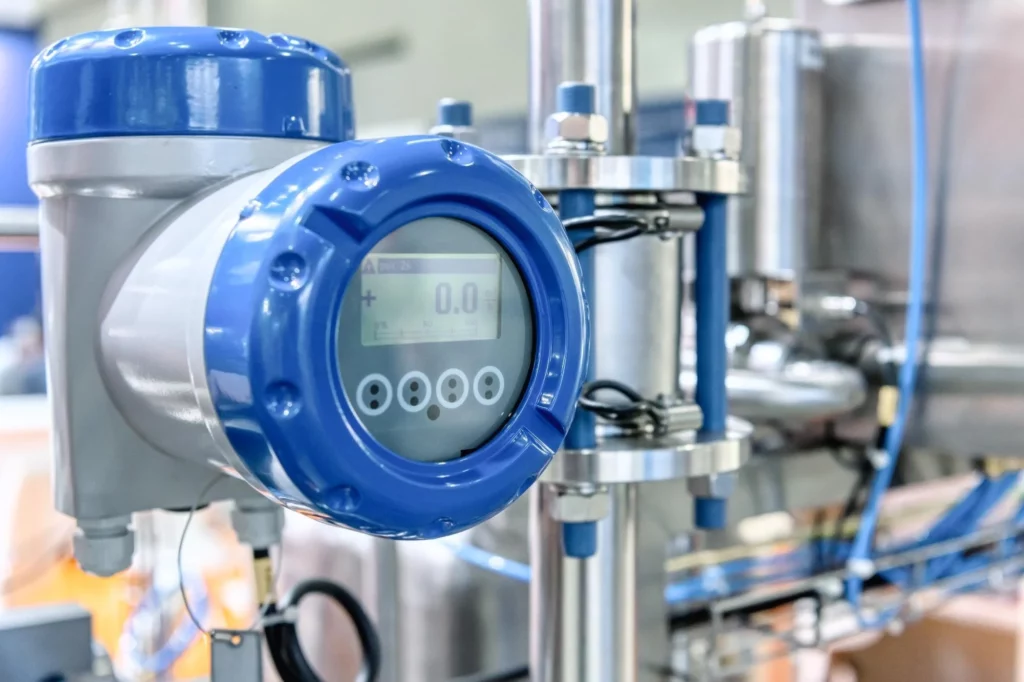
Flow meters quantify the flow in terms of volume or mass per unit of time (e.g., liters per minute or kilograms per second), facilitating accurate monitoring, process control, and billing for consumption or trade.
They come in numerous types, each suited to specific applications, fluid characteristics, and accuracy requirements. Common types include turbine, ultrasonic, electromagnetic, Coriolis, and differential pressure flow meters (details for each type are given below). The choice of flow meter depends on several factors, including the fluid type, presence of particulates, temperature, pressure conditions, and the required flow range. By providing essential data on flow rates and totals, flow meters play a crucial role in optimizing processes, enhancing efficiency, and ensuring safety and compliance in fluid handling and transfer operations.
Over the years, people who are involved in the oil and gas industry have been innovating and creating ways to get accurate measurements. From extracting to delivering these raw materials, everyone in the business has been deeply invested in getting the most accurate measurements possible.
Thus, scientists and engineers have been working long and hard to discover new ways and technologies to make more efficient metering systems. Because of their hard work, the creation of different flow meters materialized, and because of that, the oil and gas industry is still going strong today.
FLOW METERS APPLICATION IN THE OIL & GAS INDUSTRY
Flow meters in the oil and gas industry are used for:
- Custody transfer: Accurate measurement of volumes being bought, sold, or transferred.
- Process control: Regulating processes by measuring fluid flow within the system.
- Leak detection: Identifying leaks in pipelines and systems by monitoring flow rates.
- Regulatory compliance: Ensuring adherence to environmental and safety regulations by accurately measuring emissions and discharges.
WHAT MEANS CUSTODY TRANSFER?
Custody transfer, in the context of the oil and gas industry as well as other sectors dealing with bulk commodities, refers to the physical transfer of substances from one party to another. It is a critical process where ownership of the product (such as crude oil, natural gas, water, or chemicals) changes hands. This transfer is not just physical but also legal and commercial, necessitating precise measurement to determine the exact amount of product being exchanged.
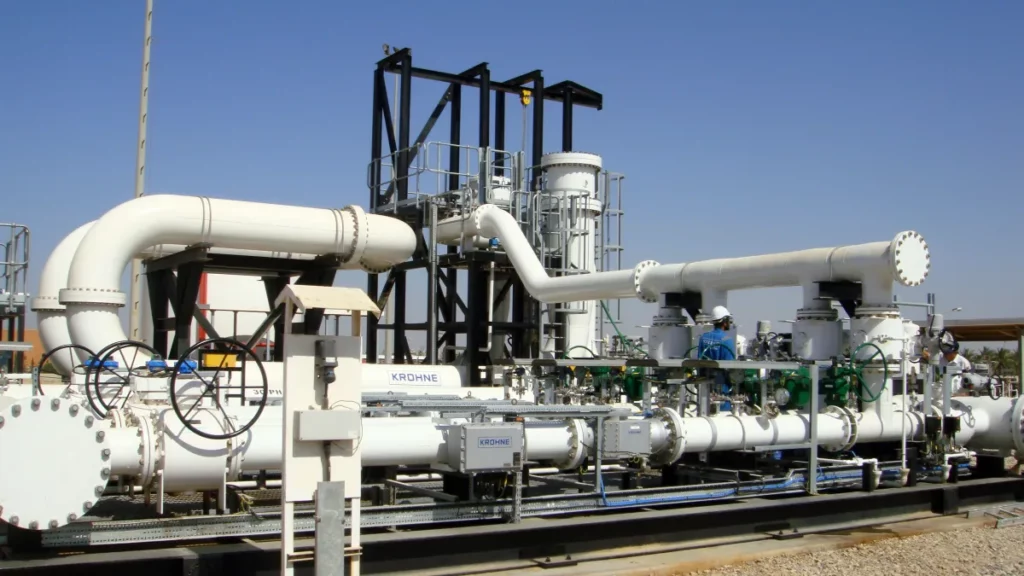
Accuracy in measuring the volume, mass, or energy content during custody transfer is paramount because these values directly impact the financial transactions between the buying and selling parties. Discrepancies can lead to significant financial losses or disputes. Therefore, standardized procedures, calibrated measurement equipment (like flow meters and quality analyzers), and often third-party verification are employed to ensure fairness and accuracy.
Custody transfer also involves documentation that details the quantity and quality of the product transferred, the time and place of the transfer, and the conditions agreed upon by both parties. This documentation is crucial for regulatory compliance, taxation, and in case of any disputes. In summary, custody transfer is a critical point in the commodity supply chain, where precise measurement and documentation are essential for legal and financial accountability.
THE 7 TYPES OF FLOW METERS IN THE OIL & GAS INDUSTRY
CORIOLIS FLOW METERS
A Coriolis flowmeter is an advanced and highly accurate instrument used for measuring the mass flow rate and density of liquids and gases passing through a pipeline. Its operation is based on the Coriolis effect, a phenomenon observed when a mass moves in a rotating frame of reference, such as a fluid flowing through a vibrating tube.
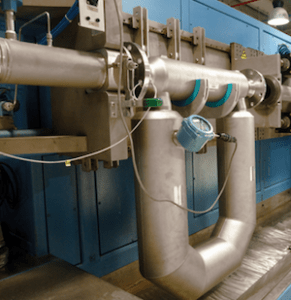
Here’s how it works and why it’s valued in various industries:
Principle of Operation
- A Coriolis flowmeter typically consists of one or more tubes that are made to oscillate at a natural frequency.
- As fluid flows through these vibrating tubes, the Coriolis forces cause a measurable phase shift or deformation in the vibration pattern.
- This shift is directly proportional to the mass flow rate of the fluid passing through the tubes.
- Additionally, by measuring the frequency of the tube’s vibration, the density of the fluid can also be determined, allowing for the calculation of volumetric flow if needed.
Key Features
- High Accuracy and Reliability: Coriolis flowmeters are known for their precision in measuring mass flow, unaffected by changes in temperature, pressure, viscosity, or density of the fluid.
- Direct Mass Flow Measurement: Unlike other flowmeters that infer mass flow through volumetric flow and density calculations, Coriolis meters measure mass flow directly.
- Multi-Parameter Measurement: Besides mass flow, these devices can measure density, temperature, and sometimes viscosity, providing a comprehensive overview of the fluid characteristics in a single device.
- No Moving Parts: The absence of moving parts in the flow path reduces maintenance needs and increases the meter’s durability and lifespan.
Applications
Coriolis flowmeters are used across a wide range of industries for various applications, including:
- Chemical and Petrochemical Industries: For precise batching, mixing, and dosing of fluids.
- Oil and Gas Sector: In upstream, midstream, and downstream operations for custody transfer, allocation measurement, and process control.
- Food and Beverage: For measuring the flow of ingredients and additives, ensuring consistent product quality.
- Pharmaceuticals: Where accurate dosing and compliance with stringent health and safety standards are paramount.
Conclusion
The versatility, accuracy, and reliability of Coriolis flowmeters make them a preferred choice for measuring fluid flow in applications where precision is critical. Despite their higher initial cost compared to other flow measurement technologies, their ability to provide accurate, direct mass flow measurement with minimal maintenance requirements often results in a lower total cost of ownership over time.
ULTRASONIC FLOW METERS
Ultrasonic flow meters are sophisticated devices used to measure the velocity of a fluid flow through a pipe, which can then be used to calculate the flow rate. They employ ultrasonic sound waves to determine the flow rate and are highly favored for their non-intrusive nature, meaning they do not require any physical insertion into the fluid flow, thus avoiding any disruption to the flow or pressure drop.
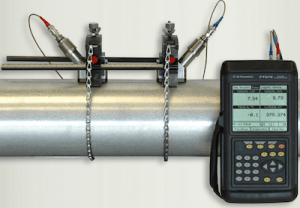
Ultrasonic flow meters are versatile and can be used across a wide range of liquid and gas flow measurements in various industries. There are two primary types of ultrasonic flow meters, based on their operational principles: Transit-Time and Doppler flow meters.
Transit-Time Ultrasonic Flow Meters
Transit-time flow meters work on the principle that sound waves traveling against the fluid flow take longer to traverse the path than those traveling with the flow. The meter sends ultrasonic pulses alternately in the direction of and against the fluid flow. By measuring the time difference between the pulses traveling downstream and those traveling upstream, the meter can calculate the velocity of the fluid. This method is highly accurate for clean, particulate-free liquids because impurities can scatter and absorb the ultrasonic waves, affecting accuracy.
Doppler Ultrasonic Flow Meters
Doppler flow meters utilize the Doppler effect, where the frequency shift of the ultrasonic signal reflects off suspended particles or gas bubbles in the fluid, is measured. When the fluid is in motion, the frequency of the reflected wave changes in proportion to the velocity of the fluid. This method is suitable for liquids that are not perfectly clear, containing suspended solids or aeration, as these characteristics are necessary for the Doppler effect to occur.
Key Features and Applications
- Non-intrusive Measurement: Ultrasonic flow meters do not contact the fluid directly, making them suitable for applications where hygiene or corrosion is a concern.
- Versatility: They can measure various types of fluids, including water, chemicals, and gases, over a wide range of flow rates and pressures.
- Maintenance and Installation: With no moving parts and an external mounting capability, ultrasonic flow meters are relatively easy to install and maintain.
- Applications: These meters are widely used in water and wastewater management, oil and gas industries, chemical processing, power generation, and many more sectors for process control, monitoring, and custody transfer applications.
Conclusion
Ultrasonic flow meters offer a non-intrusive, accurate, and versatile solution for flow measurement across a broad spectrum of applications. Whether for clean or dirty fluids, their ability to provide reliable flow data without affecting the fluid dynamics makes them an invaluable tool in modern industrial and environmental monitoring systems.
THERMAL FLOW METERS
Thermal flow meters, also known as thermal mass flow meters, are devices used to measure the mass flow rate of a gas or, less commonly, a liquid, based on the principle of heat transfer. Unlike other types of flow meters that measure the volume of the fluid passing through, thermal flow meters directly determine the mass flow rate, offering a unique advantage in applications where the density of the flowing medium can vary with temperature or pressure. These meters are particularly useful for measuring the flow of gases in various industrial processes.
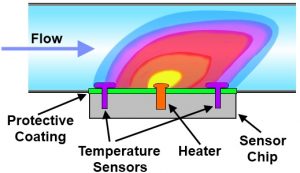
Operating Principle
The fundamental principle behind thermal flow meters involves heating a portion of the fluid and measuring the rate of heat transfer. This can be achieved through one of two primary methods:
Constant Temperature Differential: This method maintains a constant temperature difference between two sensors—a heated sensor and a temperature sensor placed downstream. As the flow rate increases, more heat is carried away from the heated sensor, and the energy required to maintain the temperature difference is proportional to the mass flow rate of the gas.
Constant Power (Hot-Wire Anemometer): In this method, a constant amount of power is applied to a heated sensor, and the temperature difference between this sensor and the fluid is measured. The temperature difference decreases as the flow rate increases, due to increased cooling of the heated element. The flow rate is then determined based on the cooling effect.
Key Features
- Direct Mass Flow Measurement: Thermal flow meters measure the mass flow rate directly, without the need for separate temperature or pressure measurements to calculate density.
- Accuracy and Sensitivity: They are highly accurate for gas flow measurements and capable of detecting very low flow rates due to the sensitivity of the thermal sensing element to changes in heat transfer.
- No Moving Parts: The absence of moving parts in the flow path reduces maintenance requirements and improves meter longevity.
- Wide Application Range: Suitable for various gases, including clean, dry gases and, in some designs, slightly moist or dirty gases.
Applications
Thermal flow meters are widely used in industries and applications where gas flow measurement is critical, such as:
- Environmental Monitoring: Measuring emissions, vent gas, and flare gas.
- Chemical and Pharmaceutical Industries: Process gas measurements, chemical reactions monitoring, and gas distribution systems.
- HVAC: Monitoring and controlling airflow in ventilation systems.
- Semiconductor Manufacturing: Controlling and monitoring specialty gas flows used in fabrication processes.
- Energy and Power: Measurement of natural gas for fuel consumption, combustion airflow, and biogas applications.
Conclusion
Thermal flow meters offer a reliable and accurate solution for measuring the mass flow rate of gases across a wide range of industrial and environmental applications. Their direct measurement capability, sensitivity to low flow rates, and low maintenance requirements make them an attractive option for many scenarios where precise gas flow measurement is essential.
TURBINE FLOW METERS
Turbine flow meters are velocity measurement devices used for the quantification of the flow rate of fluids—liquids or gases—within a pipeline. They operate on the principle that the flow rate of the fluid is directly proportional to the rotational velocity of the turbine rotor placed in the fluid stream. As the fluid moves through the meter’s body, it impinges on turbine blades that are mounted on a freely rotating rotor. The fluid’s velocity turns the rotor, with the rate of rotation being proportional to the velocity of the fluid.
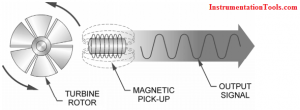
Operating Principle
The fundamental components of a turbine flow meter include the turbine rotor, which is equipped with blades or vanes; a housing that directs the fluid flow onto the rotor; and a pickup assembly (often magnetic) that detects the rotor blade’s passage, converting it into an electrical signal. Each rotation of the rotor corresponds to a specific volume of fluid passing through the meter, allowing the flow rate to be calculated based on the frequency of the electrical pulses generated by the rotor’s motion.
Key Features
- High Accuracy and Precision: Turbine flow meters are known for their high accuracy, particularly in steady, clean fluid flow conditions. They can achieve accuracy levels within ±0.5% of the flow rate under optimal conditions.
- Wide Flow Range: They can measure very low flow rates up to very high flow rates, making them versatile across a range of applications.
- Rapid Response: The turbine design allows for a quick response to changes in flow rate, which is advantageous in dynamic flow conditions.
- Linear Output: The relationship between the flow rate and the frequency of the generated electrical signal is linear, simplifying the process of flow measurement and calculation.
Applications
Turbine flow meters are used across various sectors where precise fluid flow measurement is critical, including:
- Oil and Gas Industry: For the measurement of petroleum products, natural gas, and other hydrocarbons.
- Water and Wastewater Management: For monitoring water flow in treatment plants and distribution systems.
- Chemical and Pharmaceutical Manufacturing: For dosing and process control in the production of chemicals and pharmaceuticals.
- Food and Beverage: In applications requiring sanitary flow measurement, such as in the production of beverages and liquid food products.
- Energy and Utilities: For measuring the flow of steam, gas, and water in power generation and utility applications.
Considerations
While turbine flow meters are highly effective in many situations, their performance can be affected by the fluid’s viscosity, particulate content, and flow profile. High-viscosity fluids can dampen the rotor’s rotation, while particulates can cause wear and tear on the turbine blades, affecting accuracy over time. Proper installation and maintenance are crucial to ensure the longevity and reliability of turbine flow meters.
Conclusion
Turbine flow meters offer a reliable and accurate means for measuring fluid flow velocities in a wide array of applications. Their ability to provide precise flow rate measurements across a broad range of conditions makes them invaluable in many industrial, commercial, and utility settings.
DIFFERENTIAL FLOW METERS
Differential pressure (DP) flow meters, also known as differential flow meters, are devices that measure the flow rate of a fluid by interpreting the pressure drop across a flow restriction inserted in the flow path. This method is one of the oldest and most widely used techniques for flow measurement, valued for its simplicity, reliability, and versatility. DP flow meters work on the principle that the flow rate of a fluid through a pipe is directly related to the square root of the pressure difference created by placing an obstruction within the flow.

Operating Principle
The core component of a differential pressure flow meter is the primary flow element—typically an orifice plate, venturi tube, flow nozzle, or pitot tube—that creates a constriction within the pipeline. As fluid flows through this constriction, a pressure drop occurs between the upstream and downstream sides of the obstruction. This pressure drop is measured using a differential pressure transmitter.
The relationship between the flow rate and the pressure drop is defined by Bernoulli’s principle, which states that an increase in the speed of the fluid occurs simultaneously with a decrease in pressure or a decrease in the fluid’s potential energy. The greater the flow rate, the larger the pressure drop, allowing the flow rate to be calculated based on the measured differential pressure.
Key Features
- Versatility: Suitable for measuring the flow of liquids, gases, and steam over a wide range of pressures and temperatures.
- Standardization: The dimensions and installation procedures for primary flow elements like orifice plates are well-standardized, facilitating accurate and reliable measurements.
- Simplicity and Reliability: With no moving parts in the primary flow element, DP flow meters are simple and robust, ensuring long service life with minimal maintenance.
Applications
Differential pressure flow meters are used in a variety of industrial settings, including:
- Chemical and Petrochemical Industries: For controlling and monitoring process flows.
- Oil and Gas: In upstream, midstream, and downstream operations for measurement of crude oil, natural gas, and byproducts.
- Water and Wastewater Treatment: For measuring the flow of water, wastewater, and treatment chemicals.
- Power Generation: To measure steam flow as well as cooling water.
Considerations
While differential pressure flow meters are highly effective, their performance can be influenced by several factors:
- Installation Requirements: Proper installation and placement are critical to ensure accurate measurements.
- Fluid Characteristics: Changes in the fluid’s density, viscosity, and temperature can affect the pressure drop and, therefore, the accuracy of the flow measurement.
- Energy Loss: The constriction in the flow path introduces a permanent loss of pressure and, consequently, energy within the system, which may be a consideration in the overall system design.
Conclusion
Differential pressure flow meters are a cornerstone in the field of flow measurement, offering a reliable and time-tested method for quantifying fluid flow across a broad spectrum of applications. Their adaptability to different fluids and conditions, combined with the comprehensive standardization of primary elements, makes them a staple in many industrial processes.
POSITIVE DISPLACEMENT FLOW METERS
Positive displacement (PD) flow meters, also known as volumetric flow meters, are precision instruments designed to measure the actual volume of fluid that passes through the meter. Unlike other flow measurement technologies that infer flow rate based on fluid dynamics principles, PD flow meters directly measure flow by trapping a fixed amount of fluid and counting the number of times the volume is filled and transferred. This direct measurement approach allows PD flow meters to achieve high accuracy and repeatability, even at low flow rates and with viscous fluids.
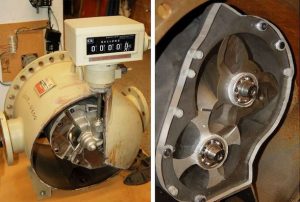
Operating Principle
The fundamental mechanism of a PD flow meter involves dividing the fluid flow into separate, measurable volumes. The meter consists of a chamber that traps a predetermined volume of fluid. Rotors, gears, pistons, or vanes within the chamber move in a specific sequence, driven by the flow of fluid. Each rotation or cycle of the mechanism represents a discrete volume of fluid passing through the meter. By counting these cycles, the total volume of fluid measured over time can be accurately determined.
Key Features
- High Accuracy and Precision: PD flow meters are renowned for their ability to provide highly accurate and repeatable measurements, making them ideal for applications requiring precise flow control and for custody transfer purposes.
- Wide Viscosity Range: They perform well across a broad range of viscosities, from light gases to heavy oils, without significant impact on accuracy.
- Low Flow Measurement: Effective at measuring very low flow rates, where other types of flow meters might struggle to maintain accuracy.
- Direct Volume Measurement: By measuring volume directly, PD flow meters eliminate the need for compensations based on temperature or pressure variations.
Applications
PD flow meters are used in diverse applications across various industries, including:
- Oil and Gas: For the accurate measurement of crude oil, refined petroleum products, and natural gas, especially in custody transfer and fiscal metering.
- Chemical and Pharmaceutical: For dosing, blending, and batch control processes where precise volume measurement is critical.
- Food and Beverage: In applications requiring sanitary conditions for measuring volumes of ingredients and final products.
- Utilities: For water and wastewater measurement, including residential water meters.
Types of Positive Displacement Flow Meters
Several types of PD flow meters are tailored to specific applications, including:
- Rotary Vane: Utilizes rotating vanes in a chamber to measure discrete volumes of fluid.
- Oval Gear: Features two oval-shaped gears that rotate synchronously to meter the flow.
- Piston: Employs a piston that moves back and forth, trapping and transferring a known volume with each stroke.
- Diaphragm: Uses a flexible diaphragm that expands and contracts, capturing and releasing measured volumes of gas or liquid.
Considerations
While PD flow meters offer several advantages, there are considerations to keep in mind:
- Wear and Tear: Moving parts are subject to wear over time, which can affect accuracy. Regular maintenance and calibration are necessary.
- Fluid Compatibility: The construction materials must be compatible with the fluid being measured to avoid corrosion or degradation.
- Pressure Drop: The mechanical nature of the flow measurement can introduce a pressure drop across the meter, which may be a concern in certain applications.
Conclusion
Positive displacement flow meters provide a reliable and accurate solution for direct volume measurement of fluid flow. Their versatility and precision make them a favored choice in applications requiring meticulous flow measurement, from the oil field to the pharmaceutical lab.
VORTEX FLOW METERS
Vortex flow meters are a type of flow measuring device that exploits the von Kármán Vortex Street principle to determine the flow rate of a fluid—liquid, gas, or steam—within a pipe. These meters are especially valued for their versatility, lack of moving parts, and ability to measure high flow rates with reasonable accuracy and minimal pressure drop.

Operating Principle
The principle behind vortex flow meters involves shedding vortices from a bluff body (a non-streamlined obstruction) placed in the path of the fluid flow. As the fluid flows past this bluff body, it creates alternating vortices on either side of the obstruction. This phenomenon is known as a von Kármán Vortex Street. The frequency of these shed vortices is directly proportional to the velocity of the fluid flow. By measuring this vortex shedding frequency, the flow meter can accurately determine the flow rate.
A sensor positioned downstream from the bluff body detects these vortices, typically using ultrasonic, piezoelectric, or capacitive means, and converts the frequency of the vortex shedding into an electronic signal that can be processed to calculate the flow rate.
Key Features
- Broad Applicability: Can measure the flow of liquids, gases, and steam over a wide range of temperatures and pressures.
- No Moving Parts: Results in lower maintenance requirements and a longer operational life compared to meters with mechanical components.
- High Accuracy and Reliability: Offers good accuracy for volumetric flow and mass flow measurements when the operating conditions are stable.
- Minimal Pressure Drop: The design of vortex flow meters generally results in a minimal pressure drop across the meter, making them efficient for use in various applications.
Applications
Vortex flow meters are used across a diverse array of industries due to their robustness and versatility:
- Chemical and Petrochemical Industries: For measuring the flow of chemicals, process fluids, and hydrocarbons.
- Energy and Power Generation: Steam flow measurement is crucial in power generation processes.
- Oil and Gas: Utilized in both upstream and downstream processes for measuring the flow of natural gas and other petroleum products.
- Water and Wastewater Treatment: For monitoring water flow in treatment plants and large distribution systems.
- Food and Beverage: Employed in applications requiring sanitary conditions and the measurement of various liquid flows.
Considerations
While vortex flow meters are highly adaptable and efficient, there are some considerations to keep in mind:
- Flow Profile and Disturbances: The accuracy of vortex flow meters can be affected by flow disturbances caused by upstream and downstream piping configurations. Proper installation and sometimes straightening vanes are required to ensure an undisturbed flow profile.
- Fluid Properties: The fluid’s viscosity, density, and conductivity (for liquids) can influence the meter’s performance. Vortex meters are best suited for relatively clean and steady flows.
- Temperature and Pressure Conditions: Extreme temperatures and pressures can affect the measurement accuracy. However, many vortex meters are designed to operate effectively under a wide range of conditions.
Conclusion
Vortex flow meters provide a reliable and efficient means for measuring fluid flow, capitalizing on the natural phenomenon of vortex shedding. Their ability to deliver accurate flow measurements across a variety of conditions, coupled with low maintenance requirements, makes them a favored choice for industrial flow measurement applications.
FLOWMETER CALIBRATION: A MUST
Calibration is a critical process for ensuring the accuracy and reliability of flow meters across various applications. It involves comparing the flow meter’s readings with a known standard or reference and then adjusting the meter’s output to match the reference accurately. Regular calibration is essential for maintaining the optimal performance of flow meters, whether they measure gas, liquid, or steam flows. Here’s an overview of the calibration needs for flow meters:
WHY CALIBRATION IS NECESSARY
- Accuracy Maintenance: Over time, the accuracy of flow meters can drift due to wear and tear, changes in the fluid’s properties, or environmental factors. Calibration ensures they continue to provide precise measurements.
- Compliance with Regulations: Many industries are governed by regulations that mandate the accuracy of flow measurements, especially in applications like custody transfer, environmental monitoring, and healthcare.
- Quality Control: In manufacturing and processing industries, accurate flow measurements are crucial for product quality. Calibration ensures that flow meters are performing within the required specifications.
- Safety: In applications involving hazardous materials, accurate flow measurement is essential for safety. Calibration helps prevent accidents caused by incorrect flow readings.
CALIBRATION FREQUENCY
The frequency of calibration depends on several factors:
- Manufacturer’s Recommendations: Manufacturers provide guidelines on how often their flow meters should be calibrated.
- Regulatory Requirements: Some industries have specific regulations that dictate calibration frequency.
- Usage Conditions: Flow meters used in harsh conditions or with corrosive, abrasive, or high-temperature fluids may require more frequent calibration.
- Criticality of Measurement: Flow meters used in critical applications where accuracy is paramount may need more frequent checks and calibrations.
CALIBRATION METHODS
- In-Situ Calibration: Some flow meters can be calibrated in place, without removing them from the pipeline. This is less disruptive but may not be as precise as off-site calibration.
- Off-Site Calibration: This involves removing the flow meter from its installation site and sending it to a laboratory for calibration. This method is usually more accurate but can be more costly and time-consuming.
- Use of Calibration Standards: Calibration often involves comparison against a known standard or master meter. These standards themselves must be traceable to national or international standards to ensure the accuracy of the calibration process.
CALIBRATION PROCESS
- Pre-Testing: Assessing the flow meter’s performance before calibration to identify any issues.
- Adjustment: The flow meter’s readings are compared to a reference, and adjustments are made until the meter’s readings align with the reference values.
- Verification: After adjustment, the flow meter is tested again to ensure it meets the required accuracy levels.
- Documentation: Calibration results are documented, providing a record of the meter’s performance over time.
Regular calibration of flow meters is essential for ensuring measurement accuracy, complying with regulations, maintaining quality control, and ensuring safety in various industrial applications. By adhering to recommended calibration frequencies and methods, organizations can ensure their flow measurement systems remain reliable and accurate, supporting efficient and safe operations.
DIFFERENCES FLOWMETERS FOR GAS VS. OIL
Flowmeters designed for gas and those intended for oil have distinctive characteristics tailored to the specific physical properties and flow behaviors of these different media. While some flowmeter technologies can measure both gas and oil flows, the design and operational parameters often vary significantly to accommodate the unique challenges posed by each. Here are the primary differences between flowmeters for gas and those for oil:
DENSITY AND VISCOSITY
- Gas Flowmeters need to account for the low density and viscosity of gases. Gases are compressible and their volume changes significantly with pressure and temperature variations. Therefore, gas flowmeters often incorporate mechanisms or calculations to correct these fluctuations to ensure accurate flow measurement.
- Oil Flowmeters are designed to handle higher density and viscosity fluids. Oils are incompressible compared to gases, but their flow characteristics can be heavily influenced by temperature, which affects viscosity. Oil flowmeters are built to be robust to manage the lubricative and sometimes abrasive nature of oils, ensuring accuracy despite these variations.
MEASUREMENT TECHNIQUE
- Gas: Technologies like thermal mass flowmeters, which measure flow based on heat dissipation, and ultrasonic flowmeters, which can compensate for the speed of sound in gases, are well-suited for gas due to their ability to accurately capture the flow rates without being influenced by the gas’s low pressure and density.
- Oil: Positive displacement and Coriolis flowmeters are commonly used for oil. Positive displacement meters offer high accuracy by measuring the volume of oil directly, ideal for billing and custody transfer applications. Coriolis meters, measuring mass flow, are unaffected by the changing viscosity of oils and provide precise flow and density measurements.
INSTALLATION AND MAINTENANCE
- For Gas Flowmeters: Special considerations are given to leak prevention and the meter’s ability to handle varying pressures and flow profiles. Gas systems may operate at higher pressures, requiring flowmeters to be designed with safety and integrity in high regard.
- For Oil Flowmeters: They are typically constructed to withstand the corrosive and sometimes particulate-laden nature of different types of oil. The robustness and ease of cleaning or maintaining the meter to handle the viscous and dirty nature of some oils are important design considerations.
APPLICATION-SPECIFIC DESIGN
- Flowmeters for gas often feature designs that minimize pressure drop across the meter, crucial for maintaining system efficiency and accuracy in gas measurement.
- Flowmeters for oil, especially in the petroleum industry, are designed to handle various types of oils with differing chemical compositions and physical properties. This includes ensuring compatibility with the corrosive nature of some oils and the ability to operate reliably in the rugged environments typical of oil extraction and processing sites.
The key differences between flowmeters for gas and those for oil reflect the physical properties of these fluids and the specific requirements of their measurement in practical applications. While some flowmeter technologies can be adapted to both gases and liquids by adjusting their design, the precision in application ensures the efficiency, accuracy, and longevity of these instruments within their respective domains.
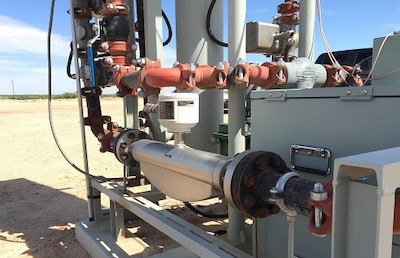

54 Responses
Hello,
I would like to reach the best point of contact to discuss buying ad space on projectmaterials.com.
Please let me know if you want to talk about this further.
Have a great day!
Thanks,
Mike Freides
E: mike@infolinks.com
P: 604-836-9491
Schedule a call: https://calendly.com/mike-freides-infolinks/30min
Hi Mike,
Thank you for reaching out and expressing your interest in buying ad space on projectmaterials.com. I understand that you would like to discuss this further and I appreciate your proactive approach.
To discuss advertising opportunities on our website, I recommend getting in touch with our advertising department. They will be able to provide you with the necessary information and guide you through the process. You can reach them at [info@projectmaterials.com].
We value your interest in our platform and look forward to the possibility of collaborating with you. Should you have any further questions or require additional information, please feel free to reach out.
Thank you once again, and have a great day!
Best regards,
Projectmaterials
Hi there to all of you. There is plenty of knowledge on this page that might help with understanding.You may also check out Rajkrupa Metal Industries or Round Bars Manufacturer in India.
Great blog, I appreciate you sharing that so much. Also, look into Manibhadra Fittings. We are a well-known producer of Medical Gas Copper Pipes in India.Visit us now at manibhadrafittings.com for the lowest rates on Medical Gas Copper Pipes Indigo Copper Pipes & other Copper Pipes and tubes.
Great blog, buddy. My name is Jissa and I work at pipingprojects.ae
Thank you for sharing this informative blog. Also,check out our. Steel Plate Weight Chart
Your articles have the power to spark positive change and create a ripple effect in the world. Thank you for using your platform to make a difference and inspire others.
Your writing not only informs but also evokes emotions and prompts introspection. Thank you for creating content that resonates deeply with your readers.
Great article! You’ve provided valuable insights and presented the information in a clear and concise manner. I appreciate how you’ve addressed the topic from different angles, making it easy for readers to grasp the concepts. The examples you’ve included also help in illustrating the key points effectively. Overall, it’s an excellent piece that offers practical knowledge and leaves readers with a sense of inspiration. Thank you for sharing your expertise! We are also the best cloud-based ERP software in India.
This article discusses the history of flow meters and how they are used in the energy sector. The selection criteria and full descriptions of available flow meter types are quite helpful. Those working in the field who want to learn more about flow measurement will find this book quite helpful. Good job!
Beautiful illustration on the tips that Flow Meters. So, happy that I found your blog. Thank you for posting this useful information over here. Appreciative content. I love reading this article. I would surely come again in this site to learn more.
The article “Flow Meters in Oil and Gas: Which One to Choose?” on projectmaterials.com is an informative guide for anyone who needs to select a flow meter for the oil and gas industry. The blog covers several types of flow meters commonly used in the industry and the applications they are best suited for, making it easy for readers to find the perfect flow meter for their needs. Additionally, the blog provides some key factors to consider when selecting a flow meter, such as accuracy, reliability, and cost.
the excellently written article also visit our useful products – Ferrule Fittings Manufacturer, Manifold Valves Manufacturer in India, Swagelok Tube Fitting Manufacturer, Instrumentation Fittings Manufacturer in India
Nice info, Goyal Steel Tubes, the oldest dealer of MS Pipes and Tubes in Delhi-NCR, deals in all sizes and variety of MS Pipes, stocked from reputed companies like APL Apollo, Jindal, Surya etc.
Send your pipe related queries on 9650705448, call on 9910495448 or find us on google- Goyal Steel Tubes click on the first link.
Wonderful blog. incredibly informative Thank you for sharing that with me. Trimac Piping Solution thought it was fantastic.
Hi very nice information you have shared we have information about the MS pipes and tubes if any one wants more details Kindly visit Goyal Steel tubes https://goyalsteeltubes.com/
I read this post your post is so nice and very informative post thanks for sharing this post.
That’s very useful information, thanks for sharing.
Also visit our site for more information – https://yugmet.com/astm-a312-stainless-steel-pipe-tube/
Thank you for sharing this vital information. You might be interested in it as well. Stainless Steel Chequered Plate, Chequered Plates Manufacturer In India and you should also visit our website Maxgrow Corporation
such an amazing blog thank you for sharing this information
our company also provides quality calibration services to produce effective output and
Air Velocity Instruments such as Air Flow Meter , Gas flow meter , Hot-wire / Vane Anemometer .
please visit our website
http://www.leomi.in
such an amazing blog thank you for sharing this information
our company also provides quality calibration services to produce effective output and
Air Velocity Instruments such as Air Flow Meter , Gas flow meter , Hot-wire / Vane Anemometer .
please visit our website
http://www.leomi.in
Nice Post. Thank You Sharing, Do visit our blog Stainless Steel Round Bar, Mehran Metals & Alloys You May Also Like: EN31 Bright Steel Round Bar Manufacturer in India
Excellent Blog! You may also checkSS Flanges Manufacturer,Stainless Steel Flanges Manufacturers in India, Stainless Steel Flange Manufacturer, Stainless Steel Flanges Manufacturers, EIL Approved Flanges, IBR Approved Flanges, fromRiddhi Siddhi Metal Impex.
Excellent Blog! You may also check SS Flanges Manufacturer,Stainless Steel Flanges Manufacturers in India, Stainless Steel Flange Manufacturer, Stainless Steel Flanges Manufacturers, EIL Approved Flanges, IBR Approved Flanges, from Riddhi Siddhi Metal Impex.
Thank You for such an informative blog, you might also like Stainless Steel Pipe Fittings Manufacturers, Stainless Steel Pipe Fittings Manufacturers in India, SS Pipe Fittings Manufacturer, from Sanjay Metal India.
Thank you for this information, do visit our blog if you interested in knowing about WordPress Vs Shopify
Thanks for sharing with us this valuable information and enabling us in achieving our goal. Also, visit us at Timex Metals and check out: Stainless Steel 316 Wire. We are a major Steel Wire Rod. Timex Metals is the top class SS Wire Manufacturers In Gujarat, SS Wire Manufacturers In Delhi, and SS Wire Manufacturers In Mumbai.
Good blog, Learnt a lot. Do visit Bhansali Wire Mesh we are one of the best Wire Mesh Manufacturer in India with inconel wire mesh and perforated pipe manufacturers in India
Good Blog, was very helpful also if you want Nut and Bolt Aashish Steel is a good option to go with. We are a Bolt Manufacturer in India and the best nut and bolt manufacturer.
Thanks for the content and Hello to everybody.
Which type of flow meter is best for measurement and local indication of flow in pulsating service (e.g. reciprocating pumps outlet). The line size is less than 2 in. and service is chemical injection package.
Does utilizing rotameter face any problem?
Excellent blog, Learn a lot. Also if you interested in Flanges trimac piping solutions is the best flanges manufacturers in india with ss flange manufacturer in ahmedabad & flange manufacturer in pune. We are one of the leading ss flanges manufacturers in india and stainless steel flanges manufacturers in india.
Excellent blog, Learn a lot. Also if you interested in Flanges trimac piping solutions is the best flanges manufacturers in india with flanges manufacturers in mumbai
& flange manufacturer in pune. We are one of the leading ss flanges manufacturers in india and stainless steel flanges manufacturers in india.
Excellent Post, Also read on Fasteners Manufacturers, High Tensile Fasteners Manufacturer and visit our website at Ananka Fasteners. We are the best Inconel Fasteners Manufacturer, Monel Fasteners Manufacturer.
Thank you for providing us with this important information and assisting us in reaching our goal. You can visit here.: Stainless Steel 316 Wire In India, Stainless Steel 316 Wire, Stainless Steel 316 Wire Manufacturers.
Such an amazing content you have shared about the usage of flow meter in oil and gas agency. Thank you!
Visit us to know more about flow meter at http://www.proteusind.com
Excellent Keep up the good work, you can also visit Riddhi Siddhi Metal Impex for India’s Top Quality Stainless Steel Flanges Manufacturers. We also Manufacturer EIL Approved Flanges & IBR Approved Flanges
Nice Info, also check on Titanium Vessel Manufacturer in India , Titanium Refineries Manufacturer in India and visit our website at Ladhani Metal Corporation.We also manufacture Titanium Butterfly Valve, and Titanium C Clamp.
Thank you for sharing
Website:Inox Steel India
For more info visit us: SS 304 seamless pipe suppliers in Mumbai, SS 304 pipe manufacturers in India, 304 Stainless Steel Pipes Suppliers, SS 304 pipe manufacturers, Stainless Steel Pipes, 304/304L Seamless Pipes
Nice Blog! Also Read on Flange Supplier in Dubai and visit our website Inco Special Alloys.We have many types of flanges, Slip on Flange,Threaded Flange and Ring Joint Flange and many more.
Your Blog is amazing and knowledgeable.I always like to read your blog and helps me to keep aware. please visit Aluminium Bronze Bar Manufacturer and Dhanwant Metal Corporation
Your Blog is amazing and knowledgeable.I always like to read your blog and helps me to keep aware. please visit Aluminium Bronze Bar Manufacturer and Dhanwant Metal Corporation
I feel good after reading your blog. Please look at gate valve suppliers in India & Gate Valves
Nice Blog! Also visit our website Inco Special Alloys and read on Flange Supplier in Dubai and Flange Manufacturer in India .We have many types of flanges, Slip on Flange,Threaded Flange and Ring Joint Flange and many more.
Thank you for sharing an informative blog. Also Visit-
Single Piece Design Ball Valves
two-piece Design Ball valve
Three piece design Ball Valves
Four Way Ball Valves
khd avlves
Thank you for sharing an informative blog. Also Visit-
Single Piece Design Ball Valves
two-piece Design Ball valve
Three piece design Ball Valves
Four Way Ball Valves
Thank you for sharing an informative blog. Also Visit-
Trimac piping solutions
Flanges Manufacturer in India
Carbon Steel IS 2062 flange
Nice Info. also check Flange Manufacturer in India and visit Inco Special Alloys. We also deal with Slip on Flange and Ring Joint Flange.
A turbine flowmeter will work either with water or clean Transmission oil without further ajustments or need to be specified as such?
Thank’s
Great and simply explained in detail.
best quality Graphene Material, Carbon NanoTubes, Carbon Fiber Powder, Electric PTC Heating Films
I wish to show thanks to you just for bailing me out of this particular trouble.As a result of checking through the net and meeting techniques that were not productive, I thought my life was done.
I wish to show thanks to you just for bailing me out of this particular trouble.As a result of checking through the net and meeting techniques that were not productive, I thought my life was done.
I just loved your blog and thanks for publishing this about the flow meters oil gas. I am really happy to come across this exceptionally well written content. Thanks for sharing and look for more in future!! Keep doing this inspirational work and share with us.
Thank you very much indeed for sharing this important information with us. It helped to to know the information about flow meters.
Great Content! I find it very useful, you have explained everything in very simple manner. I was looking forward to this type of content.